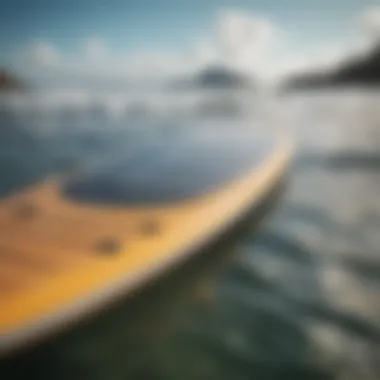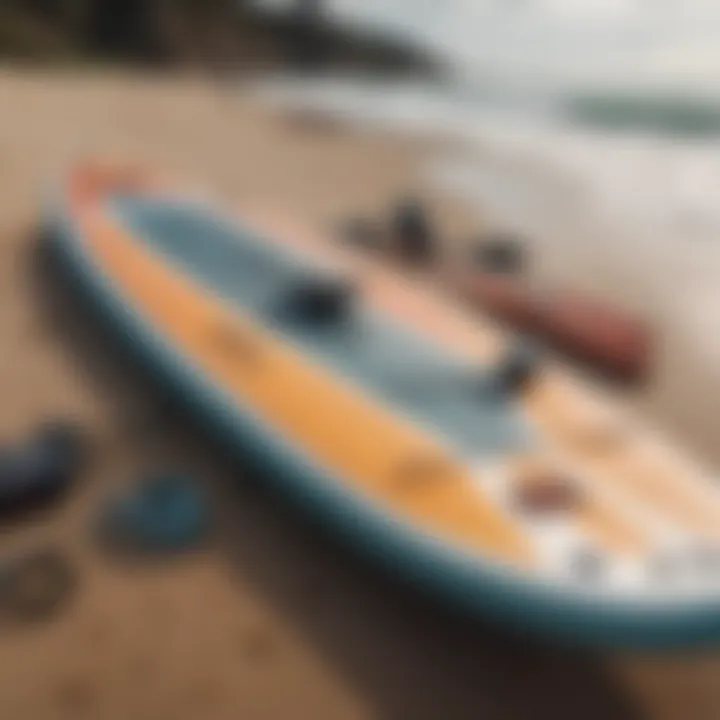A Comprehensive Guide to Paddle Boards for Heavier Users


Intro
Paddle boarding can be a liberating experience, but not all boards are created equal, especially for heavier individuals. When it comes to choosing the right paddle board, several factors weigh in—pun intended. Stability, buoyancy, and overall design play pivotal roles in ensuring not just an enjoyable ride, but a safe one as well. In this guide, we will delve into specific considerations that accommodate heavier individuals, highlight features that enhance performance, and provide insights on maintaining your equipment.
So, whether you’re a first-timer or someone with experience under your belt, understanding your options is crucial. This journey isn't just about balancing on a board; it's about having the right tools to make every excursion exhilarating rather than exhausting.
Surfboarding Techniques
Beginner Tips for Mastering the Basics
For beginners, paddle boarding can seem daunting. However, mastering the basics need not be a chore. Here are some essential tips to get started:
- Choose the Right Board: As a heavier individual, opt for wider boards designed for stability. Look out for models that have a higher weight capacity for added buoyancy.
- Start on Calm Water: Choosing a serene lake or a mild ocean cove can help ease you into the experience. Avoid choppy waters until you become more skilled.
- Posture Matters: Keep your feet shoulder-width apart and knees slightly bent. This alignment can greatly improve your balance.
- Use Your Core: Engage your core muscles to maintain stability. A strong core leads to a more controlled paddle boarding experience.
- Practice Falling: Despite your best efforts, you might take a tumble. Learning to fall safely—away from the board and into the water—can save a world of discomfort.
Advanced Techniques for Seasoned Surfers
Once you’ve got the basics down pat, it’s time to hone your skills further. Here are advanced techniques to elevate your paddle boarding game:
- Tighten Wind Conditions: As a heavier individual, learning to ride in windy conditions can enhance your abilities. Lean into the wind and maintain a low center of gravity.
- Weight Distribution: Understand how to shift your weight for turns. Disclaimer here: too much weight on one side may tilt the board.
- Paddle Techniques: Explore different paddling strokes. The J-stroke, for instance, can effectively counteract any tendency to veer off course.
- Rescue Yourself: Practice getting back on the board after a fall. Efficiently re-mounting can save energy and maintain the flow of your paddling journey.
By taking calculated risks and refining techniques, seasoned surfers often find that paddle boarding transcends mere recreation into effective body training and meditation.
Paddle Board Equipment
Reviews of the Latest Paddle Boards on the Market
When it comes to shopping for a paddle board, staying up to date on the latest models can be advantageous. Some notable boards for heavier users include:
- Red Paddle Co 10'6" Ride MSL: This inflatable board shines in stability and durability, supporting weight up to 300 lbs.
- BOTE Rackham 14: A solid hardboard option that doubles as a fishing platform, made for a weight capacity hovering around 350 lbs.
- iRocker Cruiser 10'6": Known for its ample width, this inflatable board offers improved balance, making it a great choice for beginners and seasoned paddlers alike.
Each of these boards incorporates features specifically designed to enhance stability, ensuring that users can enjoy paddle boarding without undue strain.
Essential Gear for Every Paddle Boarder
Beyond the board, some gear is essential for making the paddle boarding experience enjoyable:
- Paddle: A lightweight, adjustable paddle can reduce fatigue.
- Personal Flotation Device (PFD): For safety, a well-fitted PFD is a must.
- Leash: A leash keeps you connected to your board, preventing it from drifting away.
- Anti-UV Clothing: Protection from the sun is vital; your skin will thank you.
- Dry Bag: Store your essentials, such as water and snacks, while keeping them dry.
Investing in the right paddle board and additional gear can greatly enhance your experience on the water, allowing you to focus more on enjoying yourself and less on worrying if your board can handle your weight.
Prologue to Paddle Boarding
Paddle boarding has garnered a loyal following across diverse demographics, becoming a beloved pastime for many. The importance of understanding this activity is all the more crucial for heavy individuals who often face unique challenges and requirements when engaging with this sport. This section not only aims to clarify what paddle boarding consists of but also delves into the multifaceted benefits it provides, particularly for those on the heavier side of the scale. By highlighting these elements, we set the stage for a deeper exploration into the specifics of paddle boards designed to accommodate larger bodies.
Understanding Paddle Boarding
Paddle boarding, at its core, is the act of standing or kneeling on a buoyant board while paddling through water. This engaging sport marries the serenity of kayaking with the core-strengthening benefits of surfing. Anyone can partake—be it to explore calm lakes, navigate rivers, or ride ocean waves. For heavier individuals, having a solid grasp of paddle boarding mechanics ensures a safer and more enjoyable experience.
For example, consider the difference in buoyancy when a larger person steps onto the board compared to a lighter one. The physics involved changes the dynamics of balance inherently. Recognizing these differences helps in selecting the right type of equipment, emphasizing the importance of understanding how paddle boarding works in relation to one’s body weight.
Popularity of Paddle Boards
The surge in paddle board popularity can be traced back to its accessibility and low barrier to entry. With boards now readily available in various shapes and sizes, there exists a paddle board for everyone—from the leisurely paddler to the performance-oriented surfer. Social media has played a monumental role in propelling this trend forward, as paddle boarding images flood platforms like Instagram and Facebook, inspiring countless individuals to try their hand at it.
Recent trends suggest that the appeal is heightened by a desire for outdoor activities that promote physical fitness and mental wellness. Paddle boarding not only improves cardiovascular endurance but also fosters a deeper connection with nature. For those who may disengage from traditional exercise regimens, paddle boarding provides a fun alternative that is sustainable and uplifting.
Moreover, the paddle boarding community is inclusive, welcoming people from various backgrounds. For heavier individuals, this inclusivity is particularly vital. It motivates them to explore an engaging activity that doesn’t discriminate based on size or ability, allowing them to reap the physical and mental benefits that come along with paddle boarding.
"Paddle boarding is more than just a sport; it’s an invitation to connect with water, nature, and oneself."


As we navigate through this guide, understanding these fundamental elements sets a solid foundation for the subsequent sections on the specific challenges faced by heavier individuals and the best practices to optimize their paddle boarding experience.
Challenges for Heavy Individuals
Navigating the waters of paddle boarding as a heavy individual brings a unique set of challenges, setting it apart from the experience of lighter riders. Understanding these hurdles is not just about acknowledging their existence; it’s crucial for enhancing the overall paddle boarding experience. Heavy individuals need to carefully consider their choices to ensure enjoyment and safety on the water. Knowing the limitations and concerns can help in selecting the right gear, boosting confidence, and ultimately making each paddle an exciting venture rather than a daunting one.
Weight Limitations in Paddle Boarding
Every paddle board comes with a weight limit, often dictated by its size and the materials used. Many boards designed for lighter individuals might not perform well under extra weight. Not surprisingly, this can lead to a frustrating experience, where it feels like you’ve got one foot on the dock and the other in the water. Selecting a board with an adequate weight capacity is essential.
When testing boards, seek options that explicitly cater to heavier individuals. For instance:
- All-Around boards typically can handle more weight due to their wider surface area.
- Touring boards are made for longer distances and often feature reinforced materials, allowing for higher weight limits.
Moreover, choosing a board that is often marketed as "heavy-duty" can provide additional peace of mind, ensuring that it holds up well over time.
Stability Concerns
Stability is paramount for anyone paddle boarding, but it becomes even more critical for heavier individuals. A board that feels stable and secure can make all the difference between a relaxing glide and a precarious balancing act. In general, wider boards provide greater stability, making it less likely to capsize, especially in choppy water.
Key Factors to Consider for Stability:
- Width of the Board: Wider boards generally offer better stability, which is especially beneficial when you’re just starting out.
- Tail Design: A flatter tail often improves stability, while a pointed tail may offer speed at the cost of balance.
- Rocker Profile: Boards with a lower rocker can be more stable in flat water, while more pronounced rockers might be better for surfing.
"Stability isn’t just about feeling secure; it’s about unlocking your full paddle boarding potential."
Impact on Performance
Heavy individuals might experience distinct impacts on performance while paddle boarding. The additional weight can affect speed, maneuverability, and overall paddling efficiency. It’s not unusual to feel resistance when paddling or to expend more effort compared to lighter colleagues.
When assessing how weight can impact performance, consider the following points:
- Paddle Selection: A sturdier paddle can make a noticeable difference, offering better propulsion and less fatigue.
- Board Type: Hard boards usually glide better through water versus inflatable boards, which might absorb some energy due to flex.
- Technique: Proper body positioning can minimize drag and maximize efficiency. Leaning slightly forward while paddling can often help maintain speed.
Finding a balance between the right gear and technique is key to optimizing performance in the water. Paying attention to these details can transform a paddle boarding session from an exhausting chore into a delightful escape.
Types of Paddle Boards for Heavy Individuals
When it comes to paddle boarding for heavier individuals, the types of boards available play an integral role in ensuring stability, comfort, and performance. Knowing how each type differs can make or break your experience on the water. From various designs to materials used, understanding the nuances among the boards will help you select one that meets your needs and gives you the most bang for your buck.
All-Around Paddle Boards
All-around paddle boards are often seen as the jack-of-all-trades in the paddle boarding world. These boards are versatile enough for different paddling activities, whether it’s flat water or gentle waves. Their width and stability make them particularly appealing for heavier individuals. Typically, these boards range from about 10 to 12 feet long and are wide enough, often around 30 inches or more, to support a heavier weight.
The balance between length and width ensures that you won’t be wobbling like a tightrope walker trying to stay upright. Many all-around boards also come with extra volume to enhance buoyancy, making them a practical choice for beginners as well as seasoned paddlers who weigh more. Their adaptability is also a seller as these boards can often be used for short excursions, leisurely paddles, or even yoga sessions on the water.
Touring Paddle Boards
Touring paddle boards take the crown when it comes to long-distance paddling. They are designed for speed and efficiency, making them suitable for heavier individuals who may want to tackle longer routes without breaking a sweat. These boards are generally longer and narrower than all-around boards, offering a streamlined shape that glides through the water with ease.
The key feature to look for here is how much weight a touring board can carry. They are often rated to support a heavier load, so individuals who weigh more can still enjoy an exhilarating glide on the water without feeling like they're dragging a weight behind them. For those looking to adventure and explore, touring boards are worthy investments, providing both stability and comfort on those extended paddles.
Surf Paddle Boards
Surf paddle boards are a specialized type of board designed for riding waves. While they may seem less fitting for heavier paddlers, many new designs are emerging that cater specifically to this demographic. If you're a heavier individual with aspirations to surf, look for boards that boast wider tails and an ample surface area.
These additions help to ensure stability when catching waves, reducing the risk of wiping out. Of course, having the right dimensions is key, as a wider and thicker surf board assists in buoyancy and balance. Remember, not all surf boards made for heavier individuals are created equal, so carefully assessing design and structure can make a world of difference when catching that perfect wave.
Inflatable vs. Hard Paddle Boards


A hot debate in the paddle boarding community revolves around inflatable and hard paddle boards, especially for heavier paddlers. Inflatable paddle boards are surprisingly robust and can support significant weight while still providing buoyancy. They are also easier to transport and store, which can be a big plus for adventurers who may be hauling gear around.
On the flip side, hard paddle boards tend to offer better rigidity and performance on the water. The downside? They're bulkier and can be a hassle to transport without a proper vehicle. If stability and performance during paddling are your top priorities, a hard board may serve you well. But if convenience and ease of use are more your speed, consider an inflatable option designed specifically for higher weight limits.
"Choosing the right type of paddle board can significantly enhance the experience for heavier individuals, balancing stability and performance is essential."
Essential Features for Heavy Individuals
Choosing the right paddle board can sometimes feel like finding a needle in a haystack, especially for heavier individuals. The right features can make all the difference between a frustrating experience on the water and a delightful adventure. Thus, understanding essential features is not just important but crucial for ensuring comfort, stability, and safety. Let’s delve into the nitty-gritty here.
Board Width and Stability
When it comes to paddle boards, width is not just a number; it plays a significant role in stability. Wider boards provide a larger surface area, which means more balance for heavier riders. Think of it like a wide-legged stance when you're standing on an uneven surface—the broader the base, the steadier you are. A board with a width of at least 32 inches is often recommended for heavier individuals. The extra inches can help prevent tipping and flipping while you're paddling or enjoying the scenery.
As a general rule of thumb, heavier individuals should opt for boards described as "stable platforms". These boards are not just about satisfying weight limits; they’re specially constructed to handle a bit more mileage on the water without bowing or bending. Brands like BOTE and Hala Gear put a focus on stability, and exploring their offerings may lead to a great fit for your paddling needs.
Weight Capacity
One of the first things one should look at, when shopping for paddle boards, is the weight capacity. Some boards may look inviting, but if they can't support your weight, it’s like trying to fit a square peg into a round hole. Most boards come with a weight limit, and it's wise to choose a board that can comfortably accommodate your body weight along with any gear you might bring along.
For optimal performance, aim for a board that has a capacity at least 20% above your total weight. So, if you weigh 250 pounds, a board with a capacity of 300 pounds or more would be advisable. Ensuring that you’re within this safety margin can significantly enhance your enjoyment.
Material Considerations
The choice of material for paddle boards is not something to glaze over. Boards primarily come in two types: inflatable and solid. Inflatable boards are typically made from several layers of durable PVC. They’re great for portability and can be quite resilient, especially for heavier users. However, solid boards, often constructed from fiberglass or epoxy, can offer better performance in terms of speed and glide.
If durability is your main concern, look for boards reinforced with materials like carbon fiber or advanced composite materials. These options provide durability without sacrificing weight. Brands such as Red Paddle Co. and Naish produce high-quality boards constructed from these durable materials, ensuring that your investment stands the test of time.
Rocker and Shape Variations
Rocker refers to the curve of the board when viewed from the side. A board with a higher rocker (often referred to as a "rockered board") helps with maneuverability and is beneficial in choppy waters. However, for heavier individuals seeking stability during long paddles, a flatter board might be more advantageous.
It's also important to consider the shape of the board. A wider tail gives more stability, while a pointed nose can help with tracking and cutting through water efficiently. Finding a balance between these features can improve your overall paddling experience.
"A paddle board’s performance can hinge on these features. Take the time to assess what matters to you—whether it's stability, capacity, or construction material."
In summary, the features of a paddle board might seem trivial, but they play a pivotal role in shaping your experience on the water. When it comes to paddle boards, especially for heavier individuals, considerations like width, weight capacity, material, and rocker are your best friends. Investing some thought into these aspects is well worth your time.
Choosing the Right Paddle Board
Choosing the right paddle board is a foundational step for anyone looking to paddleboard, especially for heavy individuals. The experience on the water can significantly vary based on the board's characteristics, as well as the user’s specific needs. The board isn’t just a piece of equipment; it’s your companion on the water, and a suitable one can enhance both enjoyment and performance. Knowing how to select the right one entails understanding various factors, including personal preferences, environmental conditions, and practical trials.
Assessing Personal Needs
Every individual has unique requirements when it comes to paddle boarding. Starting with self-assessment can answer crucial questions essential to finding your ideal setup. You should reflect on your weight, experience level, and what you want out of your paddle boarding adventures.
- Weight Considerations: Choose a board with a weight limit that comfortably exceeds your body weight. If you’re on the heavier side, look for boards specifically made for higher capacities.
- Experience Level: Are you a beginner or do you have the balance of a seasoned pro? Beginners generally benefit from wider boards, which provide added stability. Conversely, experienced paddlers might prefer narrower boards for speed.
- Type of Activity: Think about what you plan to do on the water. Is it casual paddling, racing, or perhaps yoga? Knowing the purpose can steer you in the right direction.
Evaluating Local Conditions
Before making a purchase, consider the common conditions of the waters you will be paddling on. Local factors like water type, wind patterns, and the presence of currents can radically change your board choice. Here are some points to ponder:
- Flat Water: Lakes and calm rivers are forgiving environments. In this case, an all-around board with stability features can be ideal.
- Rough Waters: If you’re thinking about paddling in choppy seas or rivers with strong currents, a versatile touring board might be your best bet. Such boards often have a sharper nose that cuts through waves better than their wider counterparts.
- Wind Conditions: Winds can play havoc. If you live in a breezy area, stability is key, pushing you to consider boards with a wider design to allow for balance against gusts.
Trying Before Buying
Unless you have a magical sixth sense, trying the board before buying is a no-brainer. More than just browsing options online, getting a feel for it can clarify your needs significantly. Many shops and rental companies offer demo days or rentals. This is your chance to test the waters literally.
- How Does It Feel?: Pay close attention to how a board performs under you. Is it stable? Does it feel sluggish? Take it on a short paddle to judge its responsiveness to your movements.
- Different Sizes: Don't be shy about trying different boards. The performance can vastly differ; a minor size adjustment can make a world of difference.
- Talk to Professionals: Don’t hesitate to ask for advice from staff. Experienced paddlers often provide valuable insights on what equipment suits heavier individuals in particular.


"Finding the right paddle board is like finding the right pair of shoes. Comfort and fit are essential to avoid painful blisters or a bad experience on the water."
In summary, selecting the right paddle board goes beyond mere preference. By understanding personal needs, evaluating local conditions, and taking the initiative to try before purchasing, heavy individuals can ensure they enjoy a smooth and fulfilling experience on the water.
Safety Considerations
Life Jackets and Personal Flotation Devices
When paddling on open water, having the right safety gear is essential, especially for heavier individuals. Life jackets and personal flotation devices (PFDs) are not optional; they're vital for ensuring safety and peace of mind while out on the water. A well-fitted life jacket can help keep you buoyant should you find yourself unexpectedly in the drink. For those who may not be the strongest swimmers, this becomes even more critical. Many modern life jackets are designed for comfort and mobility, allowing you to paddle freely without feeling like you're wearing a cumbersome vest. It's worth noting that some stores have specific jackets for heavier individuals, made with added buoyancy and comfort in mind. Always remember: a life jacket should fit snugly, not tight, and should be free from excessive bulk that could hinder movement.
Understanding Your Limits
Every paddler should be aware of their own physical limits. It's easy to get swept up in the thrill of adventure, but knowing how far you can push yourself is essential to a safe experience. This means being honest about your fitness level, experience with water sports, and personal stamina. If you're new to paddle boarding, starting with calm waters and shorter durations is sensible. As you build confidence and skill, you can gradually extend your paddling ventures. Also, be mindful of external factors like weather—the wind can turn a leisurely paddle into a struggle if you're not prepared. Recognizing fatigue is crucial; if you feel you're pushing too hard, take a break. Always have a plan for returning to shore safely.
Environmental Awareness
The environment plays a significant role in paddle boarding safety. Awareness of local wildlife, water conditions, and potential hazards is crucial for preventing accidents. For instance, some areas have submerged rocks or sudden drop-offs that could easily catch someone off guard. Researching local conditions before heading out is a smart move; websites, forums like Reddit, or local paddling groups on Facebook can provide up-to-date information on water conditions and any advisories. Being conscious of weather patterns, tides, and currents can significantly enhance your paddle boarding experience too. Additionally, respecting wildlife and keeping your distance from nests or congregating animals ensures both your safety and the well-being of nature.
"Understanding your surroundings can make all the difference. A little knowledge goes a long way in keeping our adventures safe and enjoyable."
In summary, prioritizing safety on the water involves investing in proper gear, respecting your own limitations, and being informed about your environment. Adopting these principles ensures that paddle boarding remains a rewarding and enjoyable activity for everyone, regardless of size or skill level.
Paddle Board Maintenance
Taking care of your paddle board is essential, especially for heavier individuals who may put additional stress on the equipment. Proper maintenance ensures the longevity and performance of the board. Moreover, it enhances safety and can significantly improve the overall paddling experience. Think of it like tuning a car; if you allow even the smallest issues to go unchecked, they can lead to bigger problems later on. This section will delve into the fundamental aspects of paddle board maintenance, focusing on cleaning and care, storage solutions, and regular inspections.
Cleaning and Care
Cleaning your paddle board is not just about keeping it looking nice; it also plays a crucial role in maintaining its integrity. After each use, especially in saltwater or muddy conditions, rinsing the board with fresh water can prevent salt and debris from causing damage.
- Use a soft cloth or sponge: Avoid harsh scrubbers that might scratch the surface. Gentle cleaning ensures you keep that board in tip-top shape without compromising its quality.
- Check the fins and straps: Often these parts can collect dirt or even sand. Ensuring they are also clean can help in keeping everything functioning well.
- Special paddling conditions: If you've paddled through mangroves or heavy algae, use specialized cleaners designed to tackle these conditions.
"A clean board isn’t just about aesthetics; it’s about performance and longevity!"
Storage Solutions
Storing your paddle board correctly can vastly affect its lifespan. Heat, moisture, and UV rays can cause material breakdown, warping, or discoloration. Here are some ideas to keep your board in good shape:
- Indoor Storage: Whenever possible, store your board indoors, away from direct sunlight. Consider a stand or rack designed for paddle boards to keep it upright.
- Outdoors Options: If you must store it outside, invest in a UV-resistant cover. This protects it from sun damage while allowing to breathe — moisture can lead to mold.
- Avoid Pressure Points: Laying your paddle board flat in a way that puts pressure on one part can lead to warping. Maintain even weight distribution in storage.
Regular Inspections
It’s wise to treat your paddle board like a loyal companion; check on it regularly to ensure everything is functioning as it should.
- Inspect for cracks or dents: When you find a minor crease, fix it before it evolves into a significant issue. Many boards use durable materials, but wear and tear can still take a toll.
- Fins and Leash: Ensure the fins are secure, and the leash is in perfect condition. A faulty leash can spell disaster if you fall off in choppy waters.
- Air Levels in Inflatable Boards: For inflatable models, regularly check the air levels and inspect for punctures. Carry a repair kit for emergencies, just in case.
Maintaining your paddle board is essential for any serious paddle enthusiast, especially for heavier individuals who may exert more pressure on their boards. Attention to detail in cleaning, storing, and regularly inspecting your board will ensure it performs optimally for many adventures to come.
Culmination
The conclusion of this article marks a vital point for any heavy individual considering paddle boarding. It encapsulates the core themes discussed throughout, while reinforcing essential concepts that cater specifically to this demographic. When it comes to paddle boarding, the experience shouldn't be limited by one's weight but rather enriched by understanding one's unique needs and available options.
In contemplation of the various types of paddle boards, it's important to prioritize features that optimize safety and performance. This not only enhances enjoyment but also builds confidence on the water. Key elements, such as increased board width for stability, appropriate weight capacity, and material type, are more than just specifications—they represent the difference between a nagging worry and a carefree adventure. Each of these factors works synergistically to create a satisfactory paddle boarding experience, helping heavy individuals reclaim their zest for aquatic adventures.
Moreover, safety considerations cannot be overstated. The necessity of utilizing life jackets and understanding personal limits is crucial when exploring new waters. Environmental awareness should also be emphasized, as conditions can change in the blink of an eye. Embracing these precautions allows each outing to transform into an opportunity for enjoyment rather than apprehension.
Ultimately, this article serves to dispel myths and encourage heavy paddle boarders to embrace their passion. The water welcomes all, and with the right gear and knowledge, anyone can carve their own path on the waves.
Recap of Key Points
- Weight Considerations: Heavy individuals have unique needs that must be addressed for a comfortable experience.
- Board Features: Look for wider boards with higher weight capacities to ensure stability.
- Safety Precautions: Always wear a life jacket and be mindful of environmental conditions.
- Maintenance Importance: Proper care for your board can extend its life and performance.
Encouragement for Heavy Paddle Boarders
To all heavy paddle boarders, take heart in your adventures on the water. Remember that paddle boarding is not just a sport; it's a lifestyle filled with exploration and connection to nature. Every stroke of the paddle is a reminder that obstacles can be overcome with the right tools and mindset. So gear up, stay safe, and let the natural world unfold its beauty beneath you. Your journey has just begun, and the waves are waiting.















